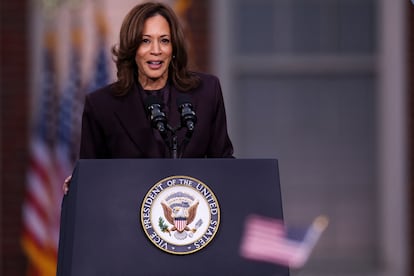Distrust of policies, the economy and Biden’s legacy: Where the Kamala Harris campaign failed
Among the factors that favored Trump and scuppered a second bid by a woman to win the White House were a slip-up on a television show and neglect of crucial issues for voters


At what point did Kamala Harris’s election campaign run aground? Was it her appearance on a television show, when she failed to describe what she would do differently than President Joe Biden, her boss for three and a half years? Did she devote too much importance to abortion rights and neglect other key issues for voters? Or was she already doomed to failure from the most sudden start of a presidential race in U.S. history?
These are some of the questions that Democratic Party strategists, campaign analysts, and academic experts are asking after a resounding defeat for the vice president by Republican Donald Trump, who has made gains among almost all demographic groups, including those who, like African American and Latino voters, have been traditional supporters of the Democrats. Trump triumphed in five of the seven swing states (Pennsylvania, Michigan, Wisconsin, Georgia, and North Carolina) and could end up winning them all. And, most strikingly, he prevailed in the popular vote, where he leads his opponent by more than five million ballots, while, with the still provisional data for Arizona and Nevada, the Democratic candidate looks to have shed almost 12 million votes compared to 2020.
“It’s the worst result I’ve ever seen. It’s been a total and absolute rejection of the Democratic Party. People don’t want to buy our product, period,” declared anonymous legislative sources on the website Punchbowl, which specializes in information about the U.S. Congress.
The vice president gave an emotional speech at Howard University in Washington on Wednesday, where she had cancelled her vote-counting party the night before, and promised to continue her fight. For the second time in eight years, after Hillary Clinton’s attempt in 2016, a woman had come close to becoming president of the United States, but neither managed to break a glass ceiling that has stood for almost a quarter of a millennium. The public figures who came out to support Harris, such as Nancy Pelosi, the emeritus speaker of the House of Representatives, wanted to make it clear that the now ex-candidate maintains the support of the party and to send an image of unity that could be put to the test when the vice president moves to the opposition in the next legislature.
Biden, who selected her as his number two four years ago and named her as his successor as the Democratic nominee after he reluctantly withdrew from the race in July, issued a statement emphasizing that “under extraordinary circumstances,” his 2020 running mate “stepped up and led a historic campaign that embodied what’s possible when guided by a strong moral compass and a clear vision for a nation that is more free, more just, and full of more opportunities for all Americans.”
But some Democrats have already begun to point to Biden himself as the culprit for the current disaster: a president in decline who insisted on running for re-election despite his fading powers, and whom voters did not want. “He shouldn’t have run,” Jim Manley, a veteran Senate aide, told Politico. “He and his staff have done an enormous amount of damage to this country.” By the time Biden dropped out, according to opinions like Manley’s, there was barely time left to turn the tables. Others point out that the fact there was no primary process prevented voters from feeling that the vice president was “theirs.”
Still, Harris started her campaign on the right foot. After strong internal pressure in the party forced Biden to announce his withdrawal, the Democratic coffers, which had almost seen donations dry up, were overflowing. Her campaign events were full. The polls did a 180-degree turn, from predicting an electoral catastrophe to putting Harris ahead of Trump, albeit very slightly. Not enough, as it turned out, to secure her victory.
As a candidate, her popularity was higher than that of the aggressive and sometimes vulgar Trump. But working against her were, among other things — a dose of misogyny among part of the electorate, for example — a global counter-current, which favors right-wing populist movements around the world.
“The level of distrust in leaders has grown all over the world, and exponentially in the United States. From the outset, it was going to be a very difficult climate for [the election of] a leader in office,” Ian Bremmer, founder of the consulting firm Eurasia Group, said in a telephone press conference on Wednesday. “Americans are not happy with their leaders or with the direction in which the country is going, and they wanted to vote for someone different. But Harris was never able to present herself as such.”
Progressive and pro-Palestinian groups in her own party denounced Harris as nothing more than an extension of Biden’s unconditional support for providing economic and military aid to Israel in the Gaza war. Moderates saw her as too progressive. Men, especially younger ones, saw her as too focused on women and abortion rights. She herself, in a response on the chat show The View to how her administration would differ from Biden’s, said that she could not think of any examples.
“That was the most important question of the entire campaign, and the answer was the worst possible,” Bremmer said. That moment marked the beginning of a gradual but noticeable decline in the polls.
“At the same time, there are a lot of people who are angry about the immigration issue. Even though those numbers are down this year, the illegal immigration that there has been in the last couple of years is still here. And inflation, even though it has gone down, is still here,” Bremmer said. These were the two issues that most concerned the electorate, and where Harris, as a representative of the current administration, showed the greatest weaknesses.
Working-class voters, most affected by rising prices and competition with newly arrived immigrants, were the great black hole of the Democratic campaign. If white workers had been leaning toward the Republicans for years, that trend has now also extended to Latinos and African Americans.
Abortion, the primary concern of young women and the first or second for many older women, should have been her strong point. Harris went all out to defend reproductive freedom, which the Supreme Court stripped of protection for the entire federal territory when it overturned the Roe v. Wade ruling in 2022.
But an issue credited with the Democrats’ relative success in the midterm elections has proven to be much less compelling two years later. Several states have passed legislation to guarantee the right, and there it has ceased to be a vital concern. Another dozen states put some form of protection to a referendum in these elections: seven approved it. Three — Florida, Nebraska, and South Dakota — rejected it.
“There’s going to be a lot of blame-shifting going on in this era,” Democratic commentator Wajahat Ali summed up on his Substack account. “But the truth is that a majority of us in the United States believed that things were going in the wrong direction, and that the economy was in bad shape even if Biden improved it from the mess he inherited from Trump.”
Sign up for our weekly newsletter to get more English-language news coverage from EL PAÍS USA Edition
Tu suscripción se está usando en otro dispositivo
¿Quieres añadir otro usuario a tu suscripción?
Si continúas leyendo en este dispositivo, no se podrá leer en el otro.
FlechaTu suscripción se está usando en otro dispositivo y solo puedes acceder a EL PAÍS desde un dispositivo a la vez.
Si quieres compartir tu cuenta, cambia tu suscripción a la modalidad Premium, así podrás añadir otro usuario. Cada uno accederá con su propia cuenta de email, lo que os permitirá personalizar vuestra experiencia en EL PAÍS.
¿Tienes una suscripción de empresa? Accede aquí para contratar más cuentas.
En el caso de no saber quién está usando tu cuenta, te recomendamos cambiar tu contraseña aquí.
Si decides continuar compartiendo tu cuenta, este mensaje se mostrará en tu dispositivo y en el de la otra persona que está usando tu cuenta de forma indefinida, afectando a tu experiencia de lectura. Puedes consultar aquí los términos y condiciones de la suscripción digital.
More information

Donald Trump gets his revenge four years later
Archived In
Últimas noticias
Petro claims the ELN was the target of US attack in Venezuela
Maduro counterattacks Trump with rhetoric and announces downing of nine drug trafficking aircraft
‘Ecce Homo’: The miraculous disaster that made a small Spanish town famous
Return to sex testing at the Olympics: IOC edges closer to banning transgender women
Most viewed
- Sinaloa Cartel war is taking its toll on Los Chapitos
- Oona Chaplin: ‘I told James Cameron that I was living in a treehouse and starting a permaculture project with a friend’
- Reinhard Genzel, Nobel laureate in physics: ‘One-minute videos will never give you the truth’
- Why the price of coffee has skyrocketed: from Brazilian plantations to specialty coffee houses
- Silver prices are going crazy: This is what’s fueling the rally









































